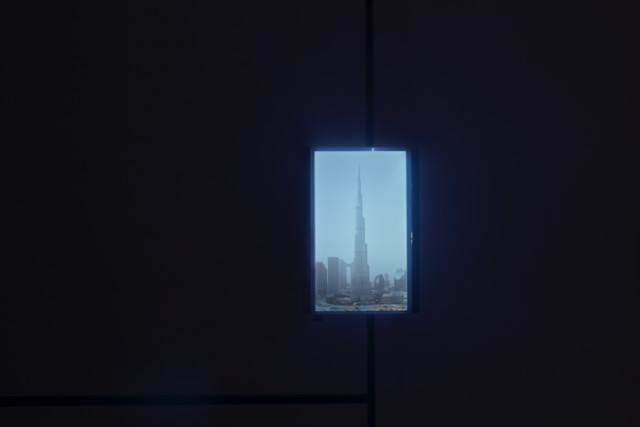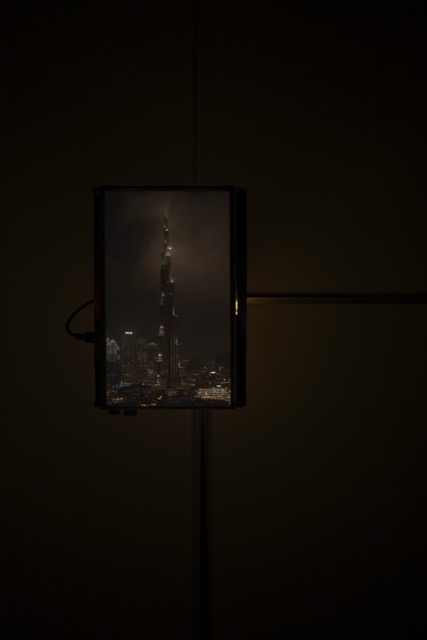EMPIRE 2020en
Over the course of a warm night in Dubai, Invernomuto filmed the tallest building on earth for six and a half hours straight. The film shows little more than the sky’s luminance changing, guided by the lights that, in the buildings being gazed at, turn on and off as time goes by. This image is portraying Burj Khalifa – a decoy built to attract everyone from everywhere. EMPIRE 2020 is, somehow, a postcard of a building that, in its configuration, is itself a postcard of that place and a late-capitalist paradigm, a highly defined image of a symbol of prestige and power of the elites of that territory.
Invernomuto’s film, EMPIRE 2020, is a remake of Andy Warhol’s 1965 film EMPIRE. Warhol, with the help of John Palmer, Jonas Mekas and others, framed the top of the Empire State Building, from another building, and filmed it uninterruptedly, for six and a half hours. Both Warhol and now the Italian duo eventually slow down their footage so the films would get to their final length of eight hours and five minutes.
Among other things, these two buildings share the fact that they have been filmed at the time when they were considered the tallest buildings ever built. Both have become pivotal for the imagery one has of each of those cities where they were planted in. They function as symbols for both societies and times. Recently, at a talk held at the MIT Architecture, named “Building and Bildung und Blackness”, Fred Moten drove over the homophonic similarities of these two words – Building and Bildung – to reflect on how architecture and projects can be seen as a form of self-picturing. How, in order to know ourselves and own ourselves, we need to have an image of ourselves. These two images, these two buildings – The Empire State Building and Burj Khalifa – are very much attached to this project of self-picturing. An architectural plan on how a society, or later societies, sees themselves. A project of urbanity towards the sky. It entangles the images we possess of those two cities. It narrows what we can expect from them. Skyscrapers turned to be the arrows of architecture and urban planning, “the stuff of heroes” as Peter Cook puts it. There, in the brutalist verticality of these structures, lay their primordial meaning and message. They are monumental because that is how a society should be: powerful, strong, memorable, and capable of seducing everyone. Based on these ideas, they gain shape. Absorbing everyone’s attention from the bottom, where they are grounded, to the top.
The way these architectural structures impose themselves on the horizontality of a landscape denotes their power and the phallocentric vision of the society that sets them up. They are vertical structures on predominantly horizontal views. They are meant to be climbed. They are the reference of a dream to reach the sky. And, most importantly, they are perceived as an impossibility, places we only see inhabited in movies or television series. They represent the economic power that one can hardly get, but still, they exist to be gazed at, and dreamt about, as a representation of the ultimate achievement of the capitalist dream.
It is in this present inaccessibility that we interact with these structures. They are unattainable, but their presence is constant, behaving like a ghost that we can’t get rid of. Both these films replicate that, while evoking the mirage these constructions are. The eight-hour length of the movies is, in most countries, the average working time per day, an immense amount of time to look at something without taking our eyes out of it, and yet, if we do, that image would still be there. And it will still be here now at Sismógrafo when we gaze back. And like Invernomuto in that night, we won’t get there. Yet there is, somehow, a sense of a vertical poetic peacefulness in this idea of watching a single-shot film for this period, staring at the nuances provoked by the light. EMPIRE 2020 asks us to gaze at a representation of society directly, lay down and watch it for the solemn purpose of doing so.
Unlike Warhol’s silent work, EMPIRE 2020 is soundtracked with a long, meditative, and generative composition, which uses the Black Med algorithm to create a continuous music stream. Black Med is an ongoing platform that the artists have been developing since 2018. It searches to reflect on the humanitarian crisis and heated geopolitical dispute visible at the Mediterranean Sea. Throughout the sonic trails left by migrations that, in the words of Iain Chambers, “resist representation, and propose an affective economy [that is] intrinsically diasporic.” For the soundtrack, Simone Bertuzzi and Simone Trabucchi traveled through the deserts of the middle east, resulting in an expansion of the project in a diversion through the Persian Gulf – a place with intense migration routes, where labor conditions for construction industry migrant workers are beyond precarious.
Text written for Invernomuto's solo show EMPIRE 2020, Sismógrafo, June 2022


